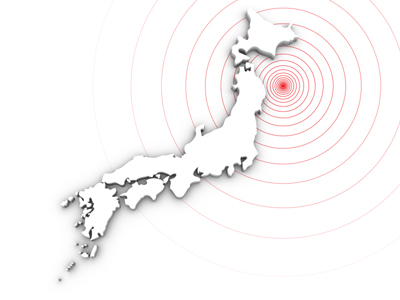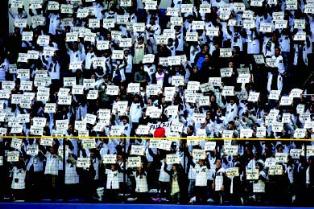Apr 11, 2011
By: Elyse Blye
Editor’s Note: At the time of publication of this article, Japan continues to experience serious aftershocks and the nuclear crisis remains unresolved.
 |
April 2011: The catastrophic 9.0 magnitude earthquake and subsequent tsunami that hit Japan on March 11, 2011, further reiterated to the world that forces of nature can be unpredictable and disastrous. When those events triggered several nuclear power plants to experience major failures, the state of emergency in Japan was further heightened.
Health care providers were faced not only with providing timely, quality care to those immediately affected by the disaster and nuclear crisis, but also to patients who had required ongoing treatments and therapies prior to the unfolding of events—including those with cancer.
Members of ASCO and of its Japanese partners, the Japan Society of Clinical Oncology (JSCO) and the Japanese Society Medical Oncology (JSMO), as well as other organizations, rushed to join global relief efforts.
A collaborative response
Collaboration and support between allied medical societies played a key role in how information was dispersed to medical professionals and to the public, explained Kazuo Tamura, MD, President of JSMO. Furthermore, it takes the coordination of efforts, resources, and locations to provide care in a timely, effective manner.
The disaster immediately prompted ASCO members and staff to reach out to their counterparts in Japan by making inquiries and offering assistance in helping patients with cancer affected by the disaster.
Collaborative relief efforts quickly took shape. For example, the day following the disaster, Naoto T. Ueno, MD, of M. D. Anderson Cancer Center, reached out to a network of professional cancer and radiation societies for help, via Twitter, with the following message: @ASTRO_org @AACR @ASCO Any valuable advice for cancer patients in Japan earthquake area. Please help!#tsunami #311care.
Concurrently, the Japanese oncology community was already active in its response. JSMO, in the midst of these events, was “not in the position to make an official statement on the radiation injuries, preventive measures, or political issues related to the nuclear crisis,” Dr. Tamura wrote in a statement to ASCO Connection. “Instead, we worked in collaboration with radiological societies and other oncology societies to improve conditions in the disaster area.”
Some relief efforts, however, proved to be more difficult.
Masahiko Nishiyama, MD, PhD, a Professor in the Research Institute for Development Therapeutics at Saitama Medical University, and President of the upcoming 49th Annual Meeting of the Japan Society of Clinical Oncology (JSCO), wrote the following in an email correspondence with ASCO:
“We, at JSCO, immediately sent some oncology professionals to the area, but they couldn’t do anything. Though the National Cancer Institute [NCI] of Japan created a support committee, the pitiful conditions in the northeast area of Japan prevented contact with patients with cancer.”
In spite of these obstacles, JSCO and its colleagues persisted in relief efforts through a shared mentality of: “I must do what I can, and I must do it now,” Dr. Nishiyama explained.
JSCO, in collaboration with other Japanese advocates, reached out to advocates of patients with cancer all over the world through a letter, asking for information on what to do in case of a dwindling drug supply; how medical and general supplies should be provided; which hospitals can accept patients with cancer for treatment; and what to do for patients with cancer in case of possible radiation exposure.
The U.S. NCI crafted a response, which addressed some of the concerns of patients who were actively undergoing treatment and general issues about environmental radiation exposure for patients who have completed treatment. NCI conferred with oncologists and members of the Radiation Epidemiology Branch in the Division of Cancer Epidemiology and Genetics, who have studied the effects of exposures from nuclear accidents and other radiation sources. “Our answers are based on knowledge gained in past radiation incidents, including Chernobyl, and should apply here, but we need to caution that there is still much that is uncertain in Japan at this time,” NCI stated in its response.
Disaster and crisis management in action
|
"We Japanese people sincerely appreciate various support from all over the world. Although things still remain serious, the situation is gradually being improved…With this support, we will get things back to normal as quickly as possible." —Atsushi Ohtsu, MD, PhD
|
In response to the tragic natural disasters and associated nuclear crisis, JSMO made a list of the hospitals and institutions where certified medical oncologists were working. It also included the names of hospitals and doctors that were able to take patients from the hospitals located in the disaster areas. The list, which can be found on JSMO’s website, was sent to major Japanese newspapers and media outlets, including NHK, Japan’s sole public broadcaster; the Japanese Ministry of Health, Labour, and Welfare; and other Japanese oncology societies.
“The system works well, and many patients with cancer who require chemotherapy have been transferred to the nearest available hospitals by using this list, and some patients have come to the Kyushu area, where I work—hundreds of miles away from the Tōhoku region,” said Dr. Tamura.
The Japanese Society for Therapeutic Radiology and Oncology (JASTRO) and the Japanese Society of Hematology (JSH) also made lists of hospitals—those that were able to take care of patients with specialty-specific needs, respective of each society.
Dr. Tamura also noted that the JSMO and JASTRO websites have been cross-linking information on radiation therapy, radioactive fallouts, and radiation injuries. “Many training hospitals certified by JSH should be able to perform hematopoietic stem cell transplantation for people who have a large amount of radiation, and more than 25% of the oncologists certified by JSMO are also hematologists—they belong to both JSH and JSMO,” Dr. Tamura said.
“We’ve closely collaborated with each other to cope with this difficult situation,” he added.
Other organizations that Dr. Tamura and colleagues referred to for disaster-relief information included:
- Japan Radiological Society (JRS)
- Japan Society of Obstetrics and Gynecology (JSOG)
- National Institute of Radiological Sciences (NIRS)
- Radiation Emergency Medicine Information Network (REMnet)
First-hand account of the disaster
 |
|
| A crowd at a baseball stadium in Chiba raised written messages that said, “Let’s do our best.” |
The moment the earthquake hit, Atsushi Ohtsu, MD, PhD—Director of Japan’s National Cancer Center Hospital East’s Research Center for Innovative Oncology, as well as Congress President of the upcoming 9th Annual Meeting of JSMO—was at work outside of Tokyo, approximately 200 miles from the earthquake’s epicenter.
“I could not stand up; I just hid under my desk at that moment. But fortunately, we did not receive any serious damage from the earthquake or tsunami,” he explained in a written statement to ASCO Connection. The extent of damage in the area, he noted, included an interruption of transportation, which prevented many people from going home for some time, and some issues with the transportation of food and oil, which had been resolved in the Tokyo area within a week. Also, Japan’s National Cancer Center Hospital East experienced short-term, planned interruption of electricity, but was able to continue functioning with the help of backup generators.
Though Dr. Ohtsu was in a relatively unharmed area, the disaster’s impact was still significant.
“I graduated from Tōhoku University and have many friends working at hospitals in the Tōhoku area. Most of the physicians in those areas worked so hard, sometimes overnight, to treat huge numbers of patients,” Dr. Ohtsu wrote. At his own institution, in the Tokyo region, Dr. Ohtsu reported that they “treated many patients with cancer who were referred from the suffering Tōhoku and north Kantō regions, since most hospitals in those areas had to concentrate on emergency patients.”
Upcoming meetings still on schedule
Japanese colleagues fully expect the Best of ASCO® Japan meeting (July 9-10, Yokohama), the 9th Annual Meeting of JSMO (July 21-23, Yokohama), and the 49th Annual Meeting of JSCO (October 27-29, Nagoya) to go as planned.
Highlights of the JSMO meeting, as noted by Dr. Ohtsu, will include symposia intended to:
- showcase presentations from the 2011 ASCO Annual Meeting and from symposia held by the European Society for Medical Oncology (ESMO) and medical oncology societies in Asia
- discuss the industry-government-academia collaboration in drug development and establishing a new standard
- provide an intensive educational program for members of the oncology care team, including pharmacists and nurses
Highlights of the JSCO meeting, as noted by Dr. Nishiyama, will include symposia intended to:
- focus on various kinds of cancer tumors and medical care, as well as treatment guidelines in Japan
- discuss the future direction for research and development in oncology and the role that Japan should play in such efforts
- highlight research from ASCO, ESMO, and the Asia Pacific Cancer Conference (APCC)
- confer measures that should be taken by JSCO in regard to 1) oncology in the community, 2) developing oncology coordinators, 3) economic support for patients with cancer, 4) clinical trials in Pan-Asia, and 5) Japan’s physician specialist system.
Life goes on
In the time following the disaster, a return to normalcy has gradually occurred. “Our daily life in Tokyo and the surrounding area have already been normalized,” said Dr. Ohtsu, three weeks after the events. Furthermore, the monitoring data for radioactivity is ranging within normal.
Despite the many hardships that Japan has faced, Japanese leadership in the oncology field has expressed a tenacious determination to keep moving forward.
“We Japanese people sincerely appreciate various support from all over the world,” said Dr. Ohtsu. “Although things still remain serious, the situation is gradually being improved…With this support, we will get things back to normal as quickly as possible.”
